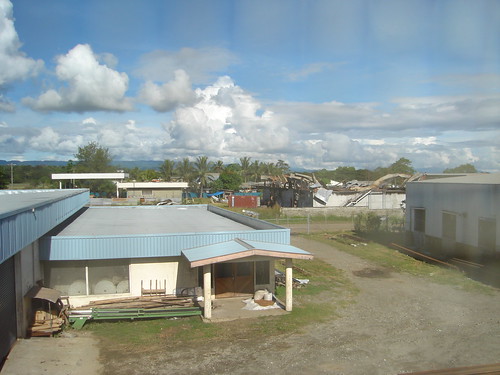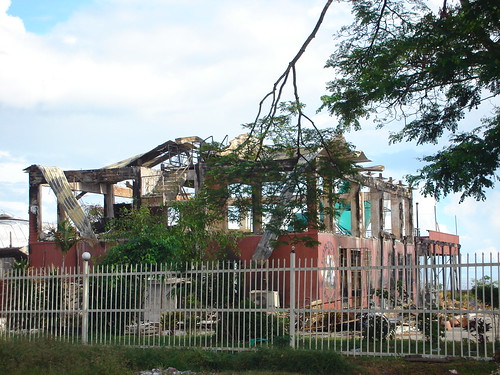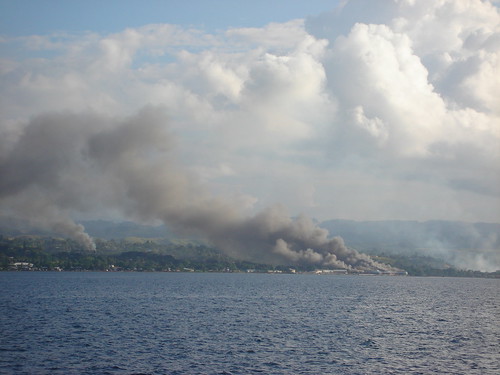
I finally got around to uploading the photos that I have of the riots in the Solomon Islands in 2006, as previously promised. I didn’t have a camera handy during the 2000 riots, which was a real shame, since groups of guys toting huge guns all over Honiara would have made for more spectacular sights, and even in 2006, I wasn’t about to take any silly risks, so these are really just photos of the aftermath. You can get much better photos of the whole thing from the BBC. I also won’t really go into the specific details of the political situation since that’s been covered by much better writers than myself.
The riots in 2006 happened after general elections that eventually put Snyder Rini into the Prime Minister’s seat. Mr. Rini had a rather unsavoury reputation, particular after his earlier stint as Finance Minister, so the word on the street was that as Prime Minister, he would be susceptible to bribes from the Chinese businessmen active locally. Or more susceptible that the norm in the Solomon Islands. Anyway, a crowd had been gathering near Parliament House to hear who would be the new Prime Minister, and when they heard that it would be Snyder Rini, they turned nasty and after being turned away by the Australian-led and supported police, descended onto the nearby Chinatown.

As always in these types of things with all kinds of rumours flying around, it isn’t easy to know precisely what happened. There’s been claims that the riots were planned by opposition politicians who egged on the protestors and certainly the police made arrests after the riots based on those claims, but in any case, hundreds of Solomon Islanders headed to Chinatown, which consisted basically of a long street of old-fashioned sundry shops run by the local Chinese, and started looting. I wasn’t there since I lived near the airport, but I watched some videos (that sadly I’ve since lost) taken by one of the shopowners hiding inside the upper storey of one of the nearby shoplots.
They showed Solomon Islanders looting the shops with impunity, while police cruiser drove by without doing anything. Where shops doors were locked or barricaded, they used whatever tools or even rocks to break padlocks. Even the elderly and little children of 5 to 6 years old were involved in walking into the shops and walking out again with anything of value that they could carry. After they were done, they set fire to the shops. A number of shops in Chinatown were spared, mainly because their owners had the forethought to hire large numbers of guards to fend off the mob, but most of the buildings on the street were looted and burnt down, as you can see from the second photo above.

The place where I stayed was some distance from Chinatown at King George VI and so was spared the worst of the looting. By the time the crowds started gathering there Chinatown was already burning and it was late evening. By nightfall, the streets were full of people milling about. We stayed in our house, turned off all the lights and peeked at them through the curtains. They started making a ruckus and throwing stones at our house soon after that. We were fortunate in that our entire compound was surrounded by a 10-foot tall sheet metal fence and we lived on the upper floor of a fairly big building in the compound. We also had guards of our own at the main gate. As you might expect we were hammering our phones to contact the police all the while. The police did send a patrol car, with Australian police cars, around a couple of time, and each time they came, the crowd dispersed. They were back soon afterwards however, and eventually the police confessed that they didn’t have the manpower to deal with the situation and we were basically on our own.
The mob at first tried to break into the compound next to us, which was a combination fuel station / car dealership / hardware store owned by our boss. We were in constant contact with the boss’ son who was the one running the business in the Solomon Islands and he managed to round up a fair number of his local employees who were willing to stand guard there, though not before quite a few broken windows and other minor damage. Then the mob broke into the warehouse on the other side of us, discovered that it was full of stuff, and spent the rest of the night looting it and, conveniently for us, ignoring us. For several hours, the streeet was thronged by people carting things off and dispersing into the surrounding villages. Someone even found a lorry to help carry things away. When they had finished stripping it clean just before dawn, they set the whole building on fire. The first picture above is the view of it from our kitchen window. We could even feel the heat of the flames from our house. Other than that warehouse, the main damage in our area was the casino and hotel complex shown in the third picture above and the row of shops near it. Those shops that belonged to Chinese were burnt down. Those that belonged to Solomon Islanders were untouched. Yes, it was personal.

When morning came, it was time to decide what to do. As you might expect, none of us had much sleep and even though we were effectively surrounded and besieged, thanks to modern technology, we were in constant contact with each other and the outside world through mobile phones and the Internet. There were persistent rumours that Australia would be sending in additional troops to retake control of the city but nothing new had emerged by morning. We’ve heard that the Chinese refugees from Chinatown were camping at the police headquarters since many had lost their homes but we weren’t in the town centre and there was no chance of any police assistance coming our way. Eventually after getting in touch with the other Malaysians in the city, we worked out a plan. A Malaysian in the country owned a passenger shipping line, so we would all converge on a nearby wharf, get on board two of the ferries in town with all the provisions we could find and then cast off. The idea was to stay safe at sea until the city calmed down, or failing that to travel to Gizo, a city in the Western Province of the country that’s the primary tourist destination and was so far free from violence.
So we collected our bags, packed instant noodles and loaves of bread and carefully travelled to the wharf in a convoy. As it turned out, the police were fully aware of our plan and evidently approved of it even though they couldn’t do anything to help out. Once we were at sea, they even occasionally sent over more stragglers to us in a small motorboat, probably thinking that they’d be safer with us than anywhere else, including the family members of the owner of the burned down casino and hotel complex. The owner himself, once he had delievered his family to the ferry, insisted that the police take him back to shore to defend his property.

We eventually spent a day and a night drifting at sea. While there was still light, we stayed away from the coast but remained in sight of land, watching the smoke from the burning city. At one point we noticed the fires getting dangerously close to the fuel storage tankers near the main port in town but thankfully the rioters had the sense to spare those. After dark, we moved further out. I think it was due to worries about the locals trying to board us in the night or something. We lashed the two ferries together and people constantly crossed from one ferry to the other. By the next day, we’d received confirmation that the Australians had indeed sent in additional forces to control the city and was enforcing a strict curfew, so we felt that it was safe to return to our homes. As it turned out, nothing much had happened on the second night, and though we feared for the worst, none of our homes has been burglarized or damaged.
The Chinese government actually arranged for the evacuation of its citizens as well as some of the Taiwanese a few days after that. Many of them had lost their homes, though many trickled back within a few months to rebuild their livelihoods. Things were still tense for a long while, but with plenty of armed Australian troops conspicuously making their presence known, there wasn’t any more violence. There were rumours for a time that a couple of Chinese children had been burnt to death in one of the houses but the rumours turned out to be false. There was not a single fatality throughout the riots, and most of the injuries were actually sustained by the police while trying to maintain order. The main difference between these riots were that the rioters weren’t armed and that there was a government, even if it lost countrol of the city for a couple of days. In my opinion, the riots in 2000 were scarier even though it wasn’t targeted specifically at the Chinese community because there lots of people toting guns and randomly shooting them. Perhaps I’ll get around to writing about that experience one day.
One thought on “Solomon Islands Riots Photos”